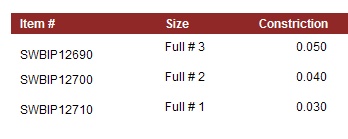Trulock Super Waterfowl Chokes
The grand lie of steel shot and level choke has been perpetuated since before steel shot was mandated in 1991. It persists today. For example, the current Browning Maxus owners manual states, referring to an Invector Plus Full choke, “* Not for use with steel shot. Using an over-tight choke constriction with steel shot will result in an ineffective “blown” pattern.” Benelli in their Super Black Eagle choke chart just says “NO” next to their Improved Modified and Full screw-chokes. Beretta, in their A400 manual states, “Full choke constrictions (0/F, 00/M) when using steel shot, do not increase pattern density and will distort normal pattern density, accelerating wear and tear.”
Are they lying? Don Zutz felt so and wrote about it long ago. Whatever they are doing, it is a very, long ways from the truth. Use of tighter than “Modified” choke constrictions absolutely does increase pattern density with steel. It always has. The problem was only that shotgun manufacturers, rather than produce stronger choke tubes of a stronger (and more costly) grade of steel to handle the additional stress of tighter constriction chokes and steel shot, took the cheaper, easier path of just lying about it. They were lying about not increasing pattern density 25 years ago with greater constrictions and steel shot, and they are still lying today. Or, perhaps they have just suffered from short-circuiting and mis-remembering, a somewhat popular trend.
There are a few exceptions. With Fabarm Exis choke tubes that come standard on Fabarm shotguns, you can use steel loads with any constriction. An Exis 9/10 Fabarm choke is nominally a .040 in. constriction, yet is steel shot approved. The new Remington V3 ships with a “Full” choke that is rated for steel shot as well: it is made from a stronger, more costly steel alloy than the IC and Mod choke tubes.

Trulock makes their super-strong “Super Waterfowl” extended choke tubes that come in three levels of constriction, all “Full” or greater. Super Waterfowl Full #1 is a .030 in. nominal constriction, Super Waterfowl Full #2 is .040 inch, and Super Waterfowl #3 is .050 inch constriction.
To test it out, I used a Remington V3 and a factory modified choke at a laser-verified 35 yards with Kent SilverSteel #2 steel 1480 fps loads. Then, I repeated the same firing with same gun, the same shell, at the same range with a Trulock Super Waterfowl Full #2 .040 inch constriction choke tube. Surely, this aggressive constriction choke would quickly show if Browning was right about their ineffective blown pattern, or if Beretta had a clue when they published that full choke constrictions “do not increase pattern density and will distort normal pattern density, accelerating wear and tear.” The answer was obvious and will be obvious to anyone who patterns their shotguns.
Yes, Don Zutz was right all along and the good folks at Beretta and Browning are either completely brainless or are well-accomplished world-class liars. I don't think they are completely brainless. Do you?
In any case, high constriction chokes do indeed shrink the pattern diameter with steel shot, yielding greater pattern density. It hardly means that the tightest possible pattern is always the better option for the individual, for we all hunt under different conditions. For 35 yard use, a Trulock Precision Hunter Modified may well be all the pattern you want or need. For 45 yard applications or even greater distances, it is highly likely that if you want a three pellet hit minimum you'll find it with an OEM Modified choke tube.
Tom Roster wrote in 1978 that with higher velocity steel loads, steel shot would become as “capable of performing as well to ranges of 70 yards in bagging waterfowl as lead loads.” Mr. Roster was apparently referring to the as yet undeveloped (in 1978) 1375 – 1500 fps steel loads. 70 yards with steel on a duck is a story for another day, but certainly if the 45 – 50 yard genre of pass-shooting is your type of hunting, high constriction chokes matched to a quality shell will increase your pattern density and give you the opportunity to place far more pellets on target.
There is another use for “Super Waterfowl” chokes, that being spring turkey hunting in areas where lead is not allowed. If you are calling your gobber in to 25 – 30 yards, your turkey targets will prove to you that a Trulock Super Waterfowl Full #2 or #3 tube and 1-1/4 oz. of #2 steel means instant turkey dinner at 30 yards.
Copyright 2016 by Randy Wakeman. All Rights Reserved.












